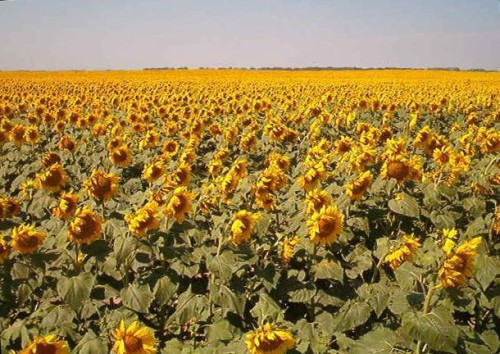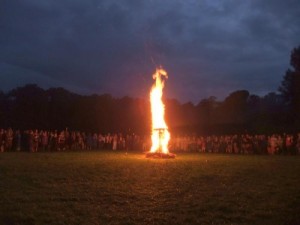TWH – For many people around the world, this weekend marks the celebration of the Summer Solstice, also known as Midsummer or Litha. It is at this time that the Northern Hemisphere is tilted closest to the sun. The astrological date for this year’s solstice is June 20, 22:34 UTC (or 6:34 pm ET).
In honor of the abundance of daylight and sunshine, communities have long used bonfires, music, dancing, and outdoor festivals as traditional features of both religious rituals and secular celebrations. In some modern Pagan practices, it is believed that this holiday represents the highest ascendancy of masculine divinity.
At the same time, our friends in the Southern Hemisphere are experiencing the exact opposite. They are coming together to celebrate and mark the winter solstice – a time of darkness, candles and inward reflection.

Sunflower fields near Fargo, SD. [Photo Credit: Hephaestos]
There are several international secular holidays that correspond to the midsummer holiday. In 1982, Make Music Day, held annually June 21, was established in France and has since spread to become a global solstice celebration of sound. And, on that same day, others will be honoring the United Nations’ official International Yoga Day, while still others will be taking to the warm summer mountain trails to celebrate Naked Hiking Day.
Additionally, the summer solstice typically falls on or around the celebration of Father’s Day in the United States. The history of this secular holiday does not have the same radical roots as its counterpart Mother’s Day. In 1908, a Washington state woman named Sonora Smart Dodd, who had been raised by a widower, wanted male parents to be honored in a similar way as mothers. In 1910, Dodd was able to convince the state to establish an official Father’s Day. The idea spread very slowly, meeting much resistance. Many felt that the holiday was silly, and others protested against the establishment of yet another commercially-focused celebration. However, after being given a boost by World War II nationalism, the unofficial Father’s Day was widely embraced by people around the country. Then, in 1972, Richard Nixon signed the proclamation that made the day an official U.S. holiday.
June also marks gay pride month — officially proclaimed this year as Lesbian, Gay, Bisexual, and Transgender Pride Month — which has grown in popularity over the past few decades. Events are specifically held in June to mark the anniversary of the Stonewall Rebellion, which happened in New York City on June 28, 1969.
Similarly, in the social spectrum, June 19 marks the formal end of slavery in the U.S. and is often called Juneteenth or Emancipation Day. While it is not widely celebrated, the holiday is reportedly becoming more popular and gaining ground in cities and local venues. The day is currently marked as an official state holiday in Texas.
While those celebrations mentioned above are all examples of secular-based traditions, there are just as many religious-based holidays that occur at this time, many of which are honored by modern Pagans, Heathens and polytheists. As already noted, there is the celebration of Litha or Midsummer, or conversely Yule and Midwinter.
The Fires of St. John festival, a Christian-holiday, is also held at this time in many countries and is closely associated with the older midsummer solstice’s traditions, including bonfires and feasts. Similar celebrations are found in many European countries, often known by different names.
In Vodun, Lucumi and other African diaspora religions, there are a number of feast days celebrated around this time, including the Feast of Ochossi and Feast of Eleggua.
In modern Hellenic reconstruction, the festival of Promethea occurs on June 21. One of the traditions is to eat fennel, which this is what Prometheos used to smuggle fire to man.

Solstice Fire at Pagan Spirit Gathering [Courtesy Photo]
“Litha or Midsummer, a time of bonfires, mugwort, mythical beings, nights and days of mischief and love. The veil is thin. The Celts, the Norse and the Slavs believed that there were three ‘spirit nights’ in the year when magic ran amok and the Otherworld was near. The first was Halloween, the second was May Eve and the third was Midsummer Eve. All sorts of enchantments are in the air now and Spirits and Fairies abound.” –
* * *
“As we honor the solstice we may reach out to the sun, but while doing so we will also reach out to those that have been lost. We will grieve for them and we will grieve with them. Hopefully the energy we raise in their remembrance will inspire us to help bring about the change that will make for better tomorrows. This Midsummer will be a somber sabbat, but that’s what it should be.” – Jason Mankey, “A Somber Solstice”
* * *
“There’s a powerful juxtaposing of realities going on right now: one is the world as we know it, with an ethos of fear and scarcity, and an ugly underbelly that’s so evident in the horrific news of recent weeks; and the other is a life-centered ethos revealed in Nature’s emerging summertime landscape of stunning beauty and overflowing abundance.” – Karen Clark, “Three Lessons from the Summer Solstice”
* * *
“If we shadows have offended,
Think but this, and all is mended,
That you have but slumbered here
While these visions did appear.” – Shakespeare, A Midsummer Night’s Dream.
* * *
However you choose to celebrate the season, a very happy solstice to everyone!
The Wild Hunt is not responsible for links to external content.
To join a conversation on this post:
Visit our The Wild Hunt subreddit! Point your favorite browser to https://www.reddit.com/r/The_Wild_Hunt_News/, then click “JOIN”. Make sure to click the bell, too, to be notified of new articles posted to our subreddit.
